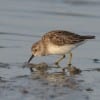 by Jim Stevenson
by Jim Stevenson
This lesson is a more advanced one than usual, more intended for the experienced birders than typical articles. Just a little meat to chew on. Many of you I met at FeatherFest, and I have a question: Would it be helpful for you to have a “program,” like a 6-8 page booklet, with schedules, pictures, events, maps, leaders and other information on it? I will pass the results along to Julia Ann, and the GOS will stand ready to help in this endeavor if needed.
Today I sadly say “bye” to the Great Salt Lake and fly to Alaska (returning mid-July). The photography has been beyond words and I have finally relaxed from a hellish and extremely busy year. Beginning this fall, among other things, I am beginning a large, tabletop book, Birds of Galveston. I am so excited about it I can hardly contain myself. 😉
OK, enjoy the tough birds below.
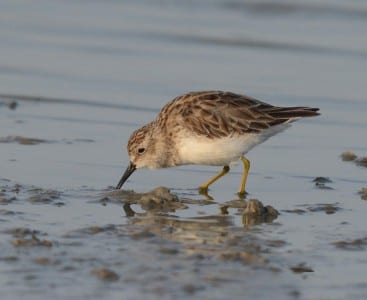
Peeps are sparrow-sized sandpipers, our smallest waterbirds. Their Old World counter¬parts are the stints (mostly ofAsia), making for good puns. Peeps feed on the surface of shorelines, usually by still water, and are most often seen in flocks. In the migration especially, they even congregate in mixed flocks, really making identification easier. The bird above is the Least Sandpiper, our most often-seen peep, although the total number of Western Sandpipers exceeds any other shorebird. Leasts are winter residents in the South, frequently feeding away from the water, and their yellow legs separate them from other peeps. They also tend to be browner on the back (this bird is still in winter plumage) and have thin bills.
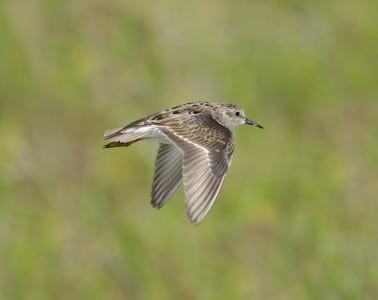
Like all sandpipers, peeps are great fliers, with all having substantial migrations. Their wings arelong and their strokes powerful. Some migrate all the way from the Arctic to near the Antarctic, though these Least Sandpipers normally winter in the southern US. Telling peeps apart in the air is tricky, but learning their call notes helps. These Leasts make an ascending “weep” call, but sounds a bit like some other peeps.
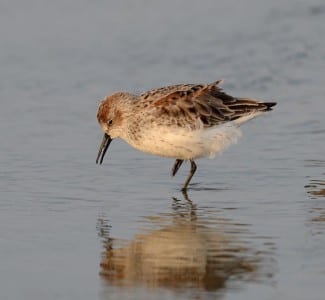
Western Sandpipers are abundant from the Atlantic to the Pacific, even nesting on the far west shores ofAlaska. Theytake on some rusty color in breeding plumagein the head and bend of the wing, and their bills are rather long with a droop on the end. My good friend Lucy Duncan would rightfully have memention the chevron patterns on the chest. Western tend to feed from the shoreline out into the shallows, while Least are normally found from that point up away from the water’s edge.
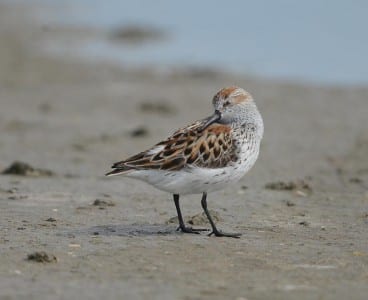
This Western is about as “breeding plumage” as they get. It seems to be preening, as birds keeping their feathers in good shape is very important to their health and survival. You can see the longish, decurved bill on this bird, as well as the chevrons reaching the belly. These and most peeps lack any webbing, except the next species.
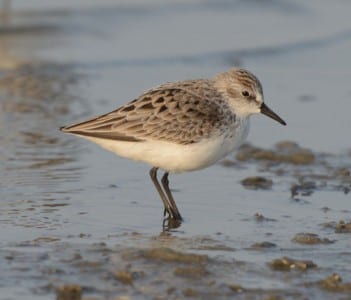
Semi-palmated Sandpipers are very common in late spring and early fall, looking somewhat like Westerns but with short bills. They tend to feed near the water’s edge, not as far out as many Westerns or as “high and dry” as most Leasts. This species tends to be more easterly, although Westerns certainly are found from ocean to ocean. Please note this species does NOT winter in the US. If you see one, get your bins cleaned.
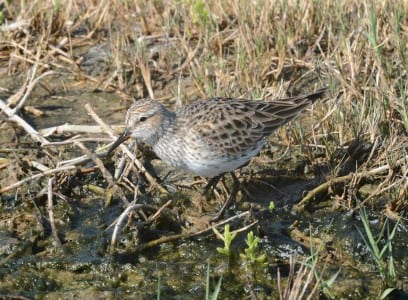
White-rumped Sandpipers are regular in late spring but almost totally absent in fall. They are best identified by their fine breast streaking, but their extremely long migrations (they have been seen in the Antarctic!) require their long wings, extending well past the tail. This species makes insect-like calls when flushed, and this also provides a great opportunity to see the white rump patch.
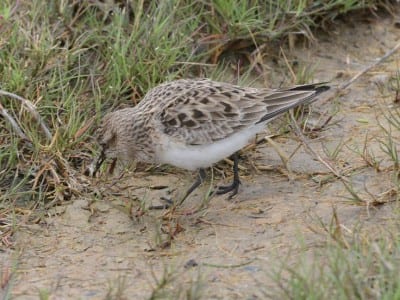
Baird’s Sandpipers are also long like white-rumps but are often quite terrestrial – even being seen in dry fields with Buff-breasted Sandpipers. The black blotches on the interior of the scapulars are diagnostic, and of course, the rump isn’t white. Baird’s are mostly April birds (late March through early May) and are also seen in early fall.
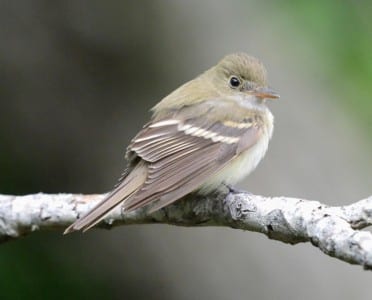
Empidonax flycatchers are a genus of small gray-to-green insectivores with a handful of species both in the American West and East. Many other species of empids are found in the New World Tropics. Empids have conspicuous wingbars; they aren’t especially long and slender (like pewees) and most have at least a semblance of an eyering. Do you know what this species is?
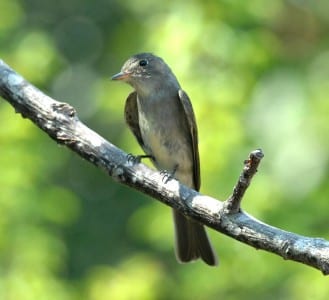
Pewees are longer than empids with virtually no eye-ring and not much in the way of wingbars. They also make long, swooping forays through open space, while empids are usually in the canopy, darting around. Oh, and about the time you are able to separate the pewees from the empids, you’ll then have to discern the Eastern from Western Wood-pewees. And then on to the Tropics for more empids and pewees…Hire a guide… 😉 More the shade of green we’re accustomed to seeing, this Acadian joined several others this spring in my yard. And yes, the first empid was one, two pages ago. Least, Willow and Alder are too gray to be Acadian and the Yellow-bellied is smaller with a big, rounded head (and see species write-up for them). This species nests in eastern wetlands and moist forests and is the only empid that breeds in much of the coastal plain of the Deep South. They are often heard first, issuing a sharp chip or an equally sharp double note. They are uncommon in Texas many migrations but nest regularly on Kirby Trail in the Big Thicket.
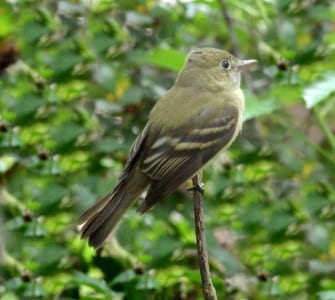
Yellow-bellied Flycatchers are small, big-headed empids with a green plumage for their deep forest home. Their eye-ring is yellow and the wingbars buffy. They stay low like the Least but seldom venture out in the open or call very much. They are a late (May) spring migrant and are seen in fall mostly in September.
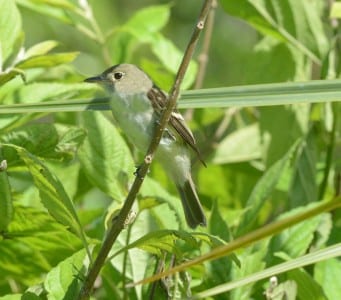
Looking like a gray Acadian, Willow and Alder Flycatchers pass through in early fall and late spring. Most of our birds seem to be Alders but they are not safely separated except by call. I believe Alders tend to have a whiter eye-ring but only the foolish think they can separate silent birds in the migration. Alders nest farther north than Willows and are quite common breeders in the (you guessed it) alders of Alaska.
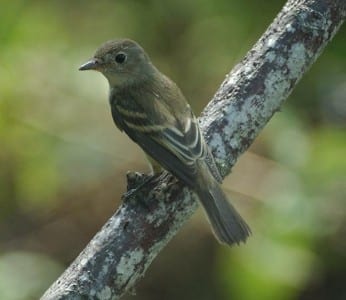
This was a Willow by call, showing the reduced eye-ring that often accompanies this species. They apparently migrate farther inland, usually leaving the coast to the Alders, but empids are troublingly silent in the migration. For a good book on separating tough groups of birds, try an author named Pyle. Can’t remember his first name, but it’s my Bible for many of the toughest IDs I have to make.* Or pass on. Too bad I didn’t have it for that stupid gull last week coz that turned out to also be a pile… • And it is NOT necessary to ID every species if the evidence isn’t there. I’m always amazed, for instance, how few unidentified peeps are turned in on spring bird counts, with the birds waaaaay out. Who are we kidding?

 Posted in
Posted in 
























